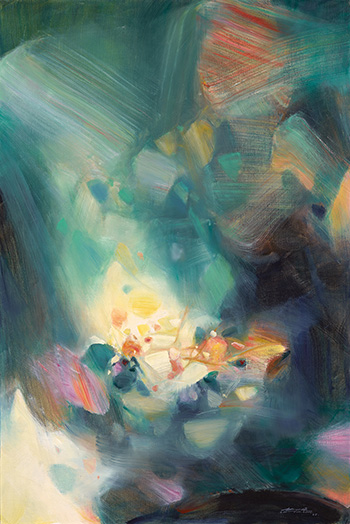EXHIBITED:
Chu Teh-chun, Shanghai Art Museum, Shanghai, October 12-November 10, 2005
ILLUSTRATED:
Chu Teh-chun, Shanghai Bookstore Publishing House, Shanghai, 2005, color illustrated, pp. 54-55
Pierre-Jean Remy, Chu Teh-chun, La Difference, Paris, 2006, color illustrated, p. 297
Solo Exhibition of Chu Teh-chun, The Ueno Royal Museum (catalogue), Tokyo; Thin Chang Corporation, Taipei, 2007, color illustrated, p. 394 (hard back edition)
Solo of Chu Teh-chun, The Ueno Royal Museum (catalogue), Tokyo; Thin Chang Corporation, Taipei, 2007, color illustrated, p. 50 (brochure)
Chu Teh-chun 88 Retrospective, National Museum of History, Taipei, 2008, color illustrated, p. 240
Catalogue Note:
Chu Teh-chun devoted himself to the arts for over 60 years during his long, now concluded, 94 year journey. He was elected a member of the Institute de France’s Academie des Beaux-Arts, the first ethnic Chinese to be granted this honor. His works are rooted in and influenced by Chinese painting, calligraphy, classical poetry, literature, philosophy, and Western art. He was once called a 20th century Song dynasty painter” (Peintre Song du XXe siecle) whose art featured the successful integration of the delicateness of Eastern art with more intense Western forms. Nature was the source of inspiration from which Chu drew continuous innovation. His paintings show a union of nature and spirituality that implies the glory of life amongst cultural practices, depicting lyrical worlds replete with mountain spirits and the energy of the land.
Looking back on his life works, Chu summed up the philosophy he wanted to pass on in this way, “As a person of Chinese descent, I realize that my life mission is to convey the two basic elements introduced in the I Ching, Yang, representing light and passion, and Yin representing nature and gentleness. My paintings try to manifest this philosophy by complementing each other and forming an endless cycle.” He continued, “I have always pursued the integration of Yin and Yang by uniting the traditional colors of Western paintings and the freer style of contemporary abstract art to create a sense of infinity. My source of inspiration is listening to the universe through nature, listening to people, listening to the East and the West, and expressing this with lyrical and poetic sentiments.”
The spirit of the East proposes that the energies of Yin and Yang harmonize with nature to achieve a synergy between mankind and heaven. Chu Teh-chun knew his cultural heritage well and applied it with the help of his brush. In 2003, for the Shanghai Opera House, he created a large-scale oil painting, “Symphonie Festive”, that displayed a symphonic rhythm and grand, festive ambiance. After this he continued to produce oil paintings, ceramics and color ink works as part of a journey of artistic exploration. In 2005, he created works such as “L'irreel” for his solo exhibition at the Shanghai Art Museum, revealing that he was still at the height of his creative powers.
“L'irreel” is a larger masterpiece from his later years. Turquoise is the base tone, like still water, concentrated and running deep, upon which pink brushstrokes leap from the canvas along with other blocks of color. Each plays an integral part in the harmony and hue of the whole structure. The brushstrokes are concise and delicate; the shading carries a poetic mood that is warm and rich in color. The painting evokes Bai Juyi’s poem, “It is a flower, yet not a flower, a mist, yet not a mist; it arrives at midnight and leaves at dawn. It appears like a spring dream, not staying long. And it vanishes as morning clouds, leaving without a trace.”
Chu Teh-chun’s romantic painting creates a space for endless imagination like the abstract mindscape of a poem intoning the evanescence of life. Professor Wang Che-hsiung described the works of Chu Teh-chun post-2000, “If Chu’s art in the 90s can be interpreted by ‘a release of power’, his art in the 2000s should be seen as ‘an internalization of power’. The works from this period, N° 50 Vers l’inconnu (2001), N° 42 Triomphe de la vie(2004), N° 45 L’aube (2004), Au Coeur du soleil (2004), Le poids du devenir (2005, Triptych), Soleils venus d’ailleurs (2005, Triptych), Ou renait la blancheu (2005), Fantaisie maritime (2005), Signes heureux (2005), L’aurore (2005), L'irreel (2005)… the contours are very simple, without extra lines, like the final touches to an already brilliant work. He transforms ‘rhythm’ into a steamy, mysterious ‘form’ as an analogy and small, lively blocks of color as a source of light that evokes Claude Lorrain (1600-1682), or that pays tribute to William Turner (1885-1851), or even whispers ‘good morning’ to Rembrandt!?” (Excerpt from The Source of Light, Image, and Rhythm—a Lecture on the Art of Chu Teh-chun, Wang Che-hsiung, 2008)
The abstract art of Chu Teh-chun represents a combination of Chinese wisdom and Western points of view that signifies both a contemporary awareness and a Chinese traditional classical spirit. It embraces both cultures while surpassing any categorization as “Eastern” or “Western”. His brush paints the world in a unique and completely charming style.
